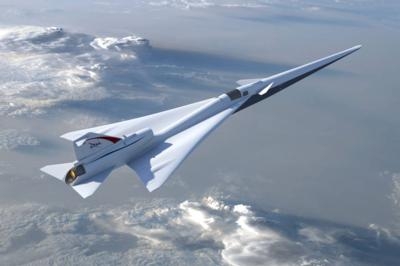Wed, Jun 28, 2017
QueSST Design Can Fulfill LBFD Mission Objectives, Engineers Conclude
NASA has achieved a significant milestone in its effort to make supersonic passenger jet travel over land a real possibility by completing the preliminary design review (PDR) of its Quiet Supersonic Transport or QueSST aircraft design. QueSST is the initial design stage of NASA’s planned Low Boom Flight Demonstration (LBFD) experimental airplane, otherwise known as an X-plane.

Senior experts and engineers from across the agency and the Lockheed Martin Corporation concluded Friday that the QueSST design is capable of fulfilling the LBFD aircraft’s mission objectives, which are to fly at supersonic speeds, but create a soft “thump” instead of the disruptive sonic boom associated with supersonic flight today. The LBFD X-plane will be flown over communities to collect data necessary for regulators to enable supersonic flight over land in the United States and elsewhere in the world.
NASA partnered with lead contractor, Lockheed Martin, in February 2016 for the QueSST preliminary design. Last month, a scale model of the QueSST design completed testing in the 8-by 6-foot supersonic wind tunnel at NASA’s Glenn Research Center in Cleveland.
"Managing a project like this is all about moving from one milestone to the next,” said David Richwine, manager for the preliminary design effort under NASA’s Commercial Supersonic Technology Project. “Our strong partnership with Lockheed Martin helped get us to this point. We’re now one step closer to building an actual X-plane.”
After the success of completing the PDR, NASA’s project team can start the process of soliciting proposals later this year and awarding a contract early next year to build the piloted, single-engine X-plane. The acquisition for the LBFD X-plane contract will be fully open and competitive, with the QueSST preliminary design data being made available to qualified bidders. Flight testing of an LBFD X-plane could begin as early as 2021.
Over the next few months, NASA will work with Lockheed on finalizing the QueSST preliminary design effort. This includes a static inlet performance test and a low-speed wind tunnel test at NASA’s Langley Research Center in Hampton, VA.
(Image provided with NASA news release)
More News
Hold Procedure A predetermined maneuver which keeps aircraft within a specified airspace while awaiting further clearance from air traffic control. Also used during ground operatio>[...]
Altitude Readout An aircraft’s altitude, transmitted via the Mode C transponder feature, that is visually displayed in 100-foot increments on a radar scope having readout cap>[...]
Aero Linx: European Hang Gliding and Paragliding Union (EHPU) The general aim of the EHPU is to promote and protect hang gliding and paragliding in Europe. In order to achieve this>[...]
Also: Skydio Chief, Uncle Sam Sues, Dash 7 magniX, OR UAS Accelerator US Secretary of the Air Force Frank Kendall was given a turn around the patch in the 'X-62A Variable In-flight>[...]
"The need for innovation at speed and scale is greater than ever. The X-62A VISTA is a crucial platform in our efforts to develop, test and integrate AI, as well as to establish AI>[...]
 ANN's Daily Aero-Term (05.09.24): Hold Procedure
ANN's Daily Aero-Term (05.09.24): Hold Procedure ANN's Daily Aero-Term (05.06.24): Altitude Readout
ANN's Daily Aero-Term (05.06.24): Altitude Readout ANN's Daily Aero-Linx (05.06.24)
ANN's Daily Aero-Linx (05.06.24) Airborne-NextGen 05.07.24: AI-Piloted F-16, AgEagle, 1st 2 WorldView Sats
Airborne-NextGen 05.07.24: AI-Piloted F-16, AgEagle, 1st 2 WorldView Sats Aero-News: Quote of the Day (05.07.24)
Aero-News: Quote of the Day (05.07.24)



